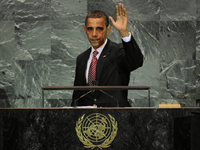On January 9th of this year the State Department confirmed that the United States was in favor of the United Nations using drones for video surveillance to ensure and monitor “peacekeeping” missions in countries around the world. The State Department said that the US could loan drones to the UN for this purpose or that the drones could be contracted by the UN through another entity. State Department spokeswoman Victoria Nuland said that the drones would be “unmanned and unarmed” and would only carry “photography equipment.” Transcript below:
VICTORIA NULAND, STATE DEPARTMENT: So on to Matt’s question about the drone idea. This is the idea that the UN peacekeeping authorities are putting forward to have unarmed UAVs participate in peacekeeping missions. This would only happen with the consent of the country or the countries where the mission would operate, and their use would not impact in any way on sovereignty. Again, they would be unarmed and they would only be carrying photographic equipment.
The United States does support the UN’s proposal to use unarmed, unmanned aerial vehicles, for example in the democratic Republic of Congo to increase the surveillance capacity of the UN peacekeeping operation MONUSCO there. The DRC Government has also welcomed the UN’s request. We’re also looking at other missions where this might be possible. We think that building on MONUSCO’s surveillance capacity will better enable it to protect civilians, and will support the efforts of the DRC to restore stability in the eastern part of the country.
QUESTION: All right. And when we’re talking about – the kind of drones we’re talking about are the kind of drone like the ones that we saw in Uganda, right? When the Secretary was visiting Ghana, they’re not much bigger than a remote control model airplane —
MS. NULAND: Right.
QUESTION: — that someone might have. They’re not – even if they’re unarmed – they’re not these enormous things that people come to think of when they think of drones.
MS. NULAND: Well, the idea from the UN’s perspective obviously is for this to be for photo surveillance, so you want to make it as cost effective —
QUESTION: Right. But I’m talking about these wee, little ones.
MS. NULAND: — as possible. So you generally go for the small – right. They’re not – maybe not this big but —
QUESTION: Yeah. Right. Okay.
QUESTION: Whatever happened to the Secretary’s idea that she brought up in Uganda about using U.S. drones possibly to find – to help – try and help find Joseph Kony?
MS. NULAND: Well, again, if we can move forward on this UN proposal to use drones, then that could be another place where they might be useful, the unarmed, unmanned.
QUESTION: Who would be operating them? Who – under whose control would they come?
MS. NULAND: Well, they can be offered by a nation. They can also be contracted services that are paid for through UN voluntary contributions. So there are any number of ways that this can be done and that it has been done in different parts of the world.
QUESTION: But who would actually operate and send them out on missions?
MS. NULAND: Again, it would be under the overall mission control of MONUSCO if you did it in the DRC, but likely the operators would be contracted.

COMMENTS
Please let us know if you're having issues with commenting.